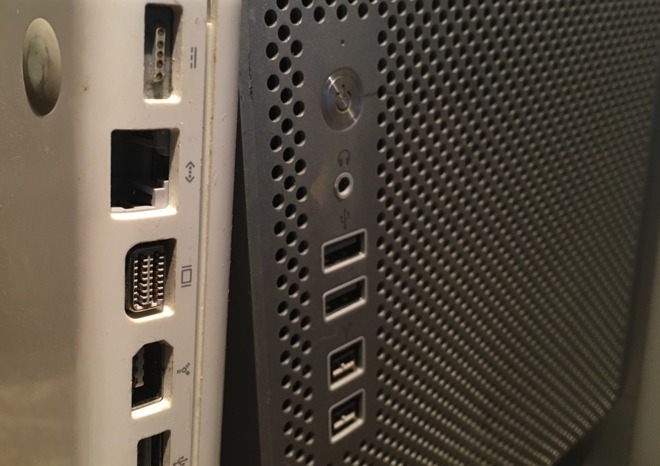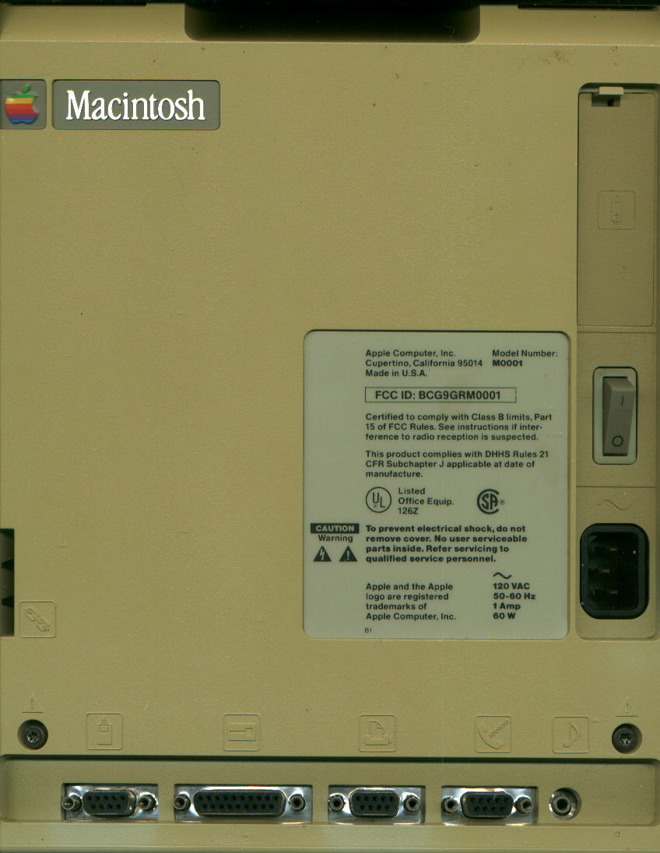There has been a near-constant debate about Apple and the choices it has made with ports and connectors spanning the company's entire history. AppleInsider takes a look back at most of the different ways Apple devices have connected over the years -- and what they tell us about the company itself.

From the original Apple computers to the many generations of Macs to the iPhone and iPad, Apple's devices have all had one thing in common: They've had to connect to something. And as the underlying technology has changed and been upgraded over time, so too have the connecting ports and plugs.
Apple has a long and storied history of going its own way with connectors on the Mac, going back to the original 128K Macintosh.
DB-9 connector and a phone cable for the keyboard

When the Macintosh line debuted in 1984, with the 128K model, it featured DB-9 connectors from the main computer to the mouse and modem, while the keyboard was connected via what was basically a coiled phone cable.
This would remain the case for the next Mac, the 512K, which arrived later in 1984, and later the 512Ke in April 1986, which was the last to feature the DB-9.
DIN-8 connector

When the Mac Plus arrived in early 1986, it offered mini DIN-8 serial ports, for the modem and printer, also operating on the RS-422 standard.
The RS422 standard allowed for networking via LocalTalk, which played a key role in the rise of the Mac itself. But the disadvantage to the DIN-8 was that it wasn't that era's standard serial port, and if the user wanted to use a printer other than Apple's own ImageWriter, it required a different plug. This was at a time when adapters on the market were not especially reliable.
The Beige PowerMac G3 would be the final desktop Mac to use the DIN-8 serial port. There were USB adapters for it available for many years from third parties.
SCSI
Apple adopted a version of the Small Computer System Interface (SCSI), debuting it on the Mac Plus in early 1986. It remained on Mac models through the Mac SE and Mac II. SCSI advantage was both daisy chain-able, and much faster than the AT attachments in use at the time.
SCSI was primarily a storage interface. But, high-speed devices like Apple's scanner line, and the LaserWriter IIsc used the protocol for connection as well.
Apple's SCSI implementation spanned multiple standards over the years, gradually getting faster over time like the protocol itself. It contributed a connector to the standard -- the HDI30 plug, found on PowerBooks like the 500 series.
Like many other things, SCSI was excised from the motherboard in the transition from the Beige G3 to the Blue and white PowerMac G3, in favor of FireWire.
ADB (Apple Desktop Bus)
The Apple Desktop Bus made its debut in 1986, with the Apple IIgs. Invented by Steve Wozniak, ADB utilized four pins, and was used to connect keyboards and mice, as well as a handful of other low-bandwidth devices.
ADB debuted in the Apple IIgs, and was brought into the Macintosh family starting with the Macintosh SE and Mac II. It even found its way onto some of Steve Jobs' NeXT computers when that company launched in the 1990s. As a bonus, it allowed users to turn on some Macs straight from the keyboard.
A major complaint about the ADB port was that it was not hot-swappable across the board. It was generally unsafe to unplug them while the machine itself was on. Some machines were able to have ADB peripherals hot-swapped, and some weren't -- but Apple was never clear on what was what.
"I have also seen the ADB port become dead because of this very same thing. Although rare, hardware damage can occur to both your computer's port and the devices you plug in," the site Low End Mac wrote in 2001.
Those looking to save money on what could be expensive ADB cables could turn to SVHS cables, as the pinouts and specs for the cables were essentially the same -- but they nearly never matched Apple's grey in use at the time.
The Apple Desktop Bus port was phased out in the late 1990s, with the arrival of USB. The final Apple product to include ADB was the blue and white Power Macintosh G3 in 1999.
Apple Attachment Unit Interface
AAUI was introduced in the late 1980s as part of an Apple system called FriendlyNet, which was used to connect computers in Ethernet networks. It utilized a 15-pin D connector on the computer end, and an assortment of connectors on the other end depending on the manufacturer and model including coaxial for token ring, and 10-base-T Ethernet jacks.
AAUI appeared on a variety of Mac models in the '90s, starting with the Macintosh Quadra in 1991. It continued to appear through the Powerbook and Power Macintosh lines until it was phased out when the Beige G3 arrived. AAUI ultimately gave way to the next generation, as the technology was getting expensive by that point as compared to the Ethernet jack integrated into a motherboard.
G3 Personality Card
The "personality" card debuted with the G3 in late 1997, and placed both stereo in/out capability and 56kbps modem on the same card. Three different cards were available, with one having a hardware DVD decode chipset.
The advantages to the personality card were mostly on Apple's side. The card allowed for easy addition of AV features, while also saving money on production costs as it allowed for one unified motherboard across the Beige G3 line.
The personality card was never used again in any other Apple model after the G3. Mac OS X arriving only a few years after the Beige G3 didn't support AV in at all.
HDI-45
The HDI-45 was a very short-lived, 45-pin, cable-to-onboard video connector, which was used only in the first generation of Power Macintosh computers in the mid-1990s. In a push by Apple towards user-friendliness, HDI-45 offered a single-cable, plug-once connection to audio, video-in, and ADB in the AudioVision 14 display.
While HD-45 didn't last long, it many ways it heralded things that came later, such as ADC and even Thunderbolt 3, in that it was an easy, single-cable solution that has worked towards Apple's overarching vision of a "one port to rule them all" concept.
No other Apple display used this connector, although adapters were available at the time.
Like so many other things, the HDI-45 was dropped when Steve Jobs returned to Apple and introduced the iMac.
NuBus and the Processor Direct Slot
NuBus, the 32-bit parallel computer bus, was developed at MIT in the late 1980s and brought to Apple products starting with the Macintosh II in 1987.
NuBus was upgraded multiple times, with an improved version later used in the Power Macintosh computers of the mid-1990s. It was also used, at the same time, by NeXT computers.
Apple dropped NuBus in the mid 90s, replacing it with conventional PCI.
NuBus was praised for its plug-and-play attributes and was favored by end-users. However, it was disliked by developers and manufacturers. Although it was a 32-bit pathway, at a time when of 8- and 16-bit displays, NuBus required a controller, and a great deal of cost and extra work for developers.
An Ars Technica discussion in 2000 referred to NuBus as "quite possibly the most idiotic expansion card bus known to man."
An off-shoot of the technology was used mostly in the LC line, and was called the PDS slot. It allowed for internal modems, the Apple IIe card, and the like. It lasted for even less time than Nubus did.
Parallel ATA
Apple switched to the parallel ATA standard, following a long run with SCSI, in the early 1990s. This happened during the era of the Mac Performas in the mid-1990s, with the change complete around the time of the launch of the blue-and-white G3 in 1999.
Apple would switch to Serial ATA (SATA) starting with the 2003 Power Mac G5 tower. SATA cut both the cost and cable size of PATA, saving not just space, but improving ventilation.
ADC
The ADC (Apple Display Connector) made its debut on the Power Mac G4 and G4 Cube.
ADC's big advantage was that it reduced cable clutter with one connection to a display from the host computer. But, at the same time, the rapid improvement in monitors at that time required users to obtain adapters to get ADC to work with their new displays.
While convenient for users that adopted it, and Apple's second attempt at a single-cable solution for input and output, ADC was phased out in 2004, following the Power Mac G5.
The mezzanine/"PERCH" slot
The slot known as "mezzanine" was something of a mystery -- it debuted in the original iMac in 1998. It was used by a few accessory manufacturers, but never gained traction and it was discontinued with the 1999 edition of the iMac.
FireWire
FireWire, the brand name for the IEEE 1394 High Speed Serial Bus, was developed by Apple back in the late '80s. It quickly became ubiquitious in Apple products but had a short shelf life, ultimately replaced relatively quickly by Thunderbolt.
The FireWire specification was ratified in 1995, and later became known as "FireWire 400," after the 400 Mbit/s speed which greatly eclipsed USB and USB 2 speeds. It drew praise from Apple enthusiasts for making SCSI termination rules a thing of the past. FireWire 800 was ratified in 2002.
. And while Steve Jobs declared Firewire "dead" in 2008, the final Mac products featuring the technology hung on until 2012, when the Thunderbolt standard took over.
FireWire had a significant impact on non-Apple products. It would become the standard for the first wave of popular digital video cameras in the early 2000s.
The 30-pin connector
This is one of the more ubiquitous connectors in Apple history. While the first few iPods connected via Firewire, the 30-pin connector was featured on the first five editions of the iPhone, as well as the first three iPads and several itineration of the iPod Touch. In a sense, it created a whole separate industry of third-party docks and other accessories, present everywhere from the bedroom to the car.
Apple's 30-pin connector carried USB, FireWire and eventually video. It could charge, while connecting to a speaker, and it helped pave the way for both thinner iPods and later the iPad through the third generation of the device.
The 30-pin was replaced by the eight-pin Lightning connector, with the release of the iPhone 5 in 2012, to much handwringing.
Connecting Through the Years
With its present setup, charging and connecting Macs with USB-C, iPhones and iPads with Lightning, and data to both wirelessly, it appears Apple has achieved much of what it's been reaching for much of its history. There's ease of use, and one cable instead of many.
Also, dongles and adapters have been a constant over computing history. Any suggestion that adapters are a new phenomenon, or that "the old Apple wouldn't have done this" is revisionist history.
However, there remain additional frontiers- including unconfirmed rumors of Apple removing Lightning from forthcoming iPhones altogether. That may not happen, but if Apple has taught us anything, it's that it will always continue to innovate not only devices themselves, but the ways they connect.